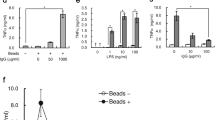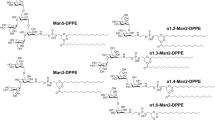Abstract
To determine the role of intracellular calcium ([Ca2+]i) in the priming of monocytes (MΦ) by bacterial lipopolysaccharide (LPS), the membrane expression of two functional proteins and phagocytosis and respiratory burst were examined by microfluorimetry. LPS induced a significant increase in HLA-DR and C3bi receptor (CR3) expression within 2 h of its addition to whole blood. The enhanced expression of both antigens by LPS was dose-dependent, with concentrations as low as 0.1 ng/ ml producing a response. The involvement of [Ca2+]i was demonstrated by loading isolated MΦ with the intracellular calcium chelator quin-2 or the inhibitor of intracellular calcium redistribution TMB-8 prior to addition of LPS. Both compounds inhibited the LPS-induced increase in HLA-DR and CR3 expression. No role for extracellular calcium, for calcium slow channel flux, or for the calcium-calmodulin complex in LPS priming was demonstrated when LPS was added in the presence of EGTA, trifluperazine (TFP), or verapamil. The addition of the calcium ionophores A23187 or ionomycin failed to increase expression of either antigen. Prior exposure to LPS primed MΦ for enhanced phagocytosis and respiratory burst activity. These functions were inhibited by TMB-8, but not by TFP or verapamil. Addition of LPS to isolated MΦ increased [Ca2+]i by 23% at 30 sec and 42% at 5 min, as measured by the calcium-sensitive, intracellular probe indo-1. These results suggest that intracellular Ca2+ mobilization is necessary, but not sufficient, for LPS-induced priming of human peripheral blood monocytes.
Similar content being viewed by others
References
Cooper, P. H., P. Mayer, andM. Baggiolini, 1984. Stimulation of phagocytosis in bone marrow-derived mouse macrophages by bacterial lipopolysaccharide: Correlation with biochemical and functional parameters.J. Immunol. 133:913–922.
Morrison, D. C., andJ. L. Ryan, 1979. Bacterial endotoxins and host immune responses.In Advances in Immunology, Vol28. F. J. Dixon and H. G. Kunkel, Editors. Academic Press, New York. 293–450.
Morland, B., andG. Kaplan. 1977. Macrophage activation in vivo and in vitro.Exp. Cell. Res. 108:279–288.
Pabst, M. J., andR. B. Johnston, Jr. 1980. Increased production of superoxide anion by macrophages exposed in vitro to muramyl dipeptide or lipopolysaccharide.J. Exp. Med. 151:101–114.
Kaku, M., K. Yagawa, S. Nagao, andA. Tanaka. 1983. Enhanced superoxide anion release from phagocytes by muramyl dipeptide or lipopolysaccharide.Infect. Immunol. 39:559–564.
Morland, B. 1979. Studies on selective induction of lysosomal enzyme activities of mouse peritoneal macrophages.J. Reticuloendothel Soc. 26:749–762.
Taramelli, D., andL. Varesio. 1981. Activation of murine macrophages. I. Different pattern of activation by poly I-C than by lymphokine or LPS.J. Immunol. 127:58–63.
Doe, W. F., andP. M. Henson. 1979. Macrophage stimulation by bacterial lipopolysaccharides. III. Selective unresponsiveness of C3H/HeJ macrophages to the lipid A differentiation signal.J. Immunol. 123:2304–2310.
Cameron, D. J., andW. H. Churchill. 1980. Cytotoxicity of human macrophages for tumor cells: Enhancement by bacterial lipopolysaccharides (LPS).J. Immunol. 124:708–712.
Sasada, M., andR. B. Johnston. 1980. Macrophage microbicidal activity. Correlation between phagocytosis-associated oxidative metabolism and the killing ofCandida by macrophages.J. Exp. Med. 152:85–98.
Ziegler, H. K., L. K. Staffileno, andP. Wentworth. 1984. Modulation of macrophage la-expression by lipopolysaccharide. I. Induction of Ia expression in vivo.J. Immunol. 133:1825–1835.
Todd, R. F., P. A. Alvarez, D. A. Brott, andD. Y. Liu. 1985. Bacterial lipopolysaccharide, phorbol myristate acetate, and muramyl dipeptide stimulate the expression of human monocyte surface antigen, Mo3e.J. Immunol. 135:3869–3877.
Hamilton, T. A., M. M. Jansen, S. D. Somers, andD. O. Adams. 1986. Effects of bacterial lipopolysaccharide on protein synthesis in murine peritoneal macrophages: Relationship to activation for macrophage tumoricidal function.J. Cell. Physiol. 128:9–17.
Prpic, V., J. E. Weiel, S. D. Somers, J. Diguiseppi, S. L. Gonias, S. V. Pizzo, T. A. Hamilton, B. Herman, andD. O. Adams. 1987. Effects of bacterial lipopolysaccharide on the hydrolysis of phosphatidylinositol-4,5-bisphosphate in murine peritoneal macrophages.J. Immunol. 139:526–533.
Wightman, P. D., andC. R. H. Raetz. 1984. The activation of protein kinase C by biologically active lipid moieties of lipopolysaccharide.J. Biol. Chem. 259:10048–10052.
Weiel, J. E., T. A. Hamilton, andD. O. Adams. 1986. LPS induces altered phosphate labeling of proteins in murine peritoneal macrophages.J. Immunol. 136:3012–3018.
Strassman, G., S. D. Somers, T. A. Springer, D. O. Adams, andT. A. Hamilton. 1986. Biochemical models of interferon-τ-mediated macrophage activation: Independent regulation of lymphocyte function associated antigen (LFA)-1 and I-A antigen on murine peritoneal macrophages.Cell. Immunol. 97:110–120.
Onozaki, K., T. Takenawa, Y. Homma, andT. Hashimoto. 1983. The mechanism of macrophage activation induced by Ca2+ ionophore.Cell. Immuno. 75:242–254.
Drysdale, B. E., C. M. Zacharchuk, andH. S. Shin. 1983. Mechanism of macrophagemediated cytotoxicity: Production of a soluble cytotoxic factor.J. Immunol. 131:2362–2367.
McLeish, K. R., G. T. Stelzer, D. S. Eades, andJ. H. Wallace. 1985. Alterations in serum antibody and peripheral T-lymphocyte subsets resulting from treatment of murine immune complex glomerulonephritis with PGE2.Clin. Immunol. Immunopathol. 34:100–108.
McLeish, K. R., G. T. Stelzer, D. S. Eades, R. Cohen, andJ. H. Wallace. 1985. Serial changes in humoral and cellular immunity induced by prostaglandin E2 treatment of murine immune complex glomerulonephritis.J. Lab. Clin. Med. 106:517–523.
Hoffman, R. A., andW. P. Hansen. 1981. Immunofluorescent analysis of blood cells by flow cytometry.Int. J. Immunopharmacol. 3:249–254.
Trinkle, L. S., S. R. Wellhausen, andK. R. McLeish. 1987. A simultaneous flow cytometric measurement of neutrophil phagocytosis and oxidative burst in whole blood.Diagn. Clin. Immunol. 5:62–68.
Adams, D. O., andT. A. Hamilton. 1984. The cell biology of macrophage activation.Annu. Rev. Immunol. 2:283–318.
McCartney, A. C., andA. C. Wardlaw. 1985. Endotoxic activities of lipopolysaccharides.In Immunology of the Bacterial Cell Envelope. D. E. S. Stewart-Tull and M. Davies, editors. John Wiley & Sons, New York. 203–238.
Gewurz, H., H. S. Shin, andS. E. Mergenhagen. 1968. Interactions of the complement system with endotoxic lipopolysaccharid: Consumption of each of the six terminal complement components.J. Exp. Med. 128:1049–1057.
Lucas, D. O., andL. B. Epstein. 1985. Interferon and macrophages.In The Reticuloendothelial System. S. M. Reichard, and J. P. Filkins, editors. Plenum Press, New York. 145.
Yancey, K. B., J. O'Shea, T. Chused, E. Brown, T. Takahashi, M. M. Frank, andT. J. Lawley. 1985. Human C5a modulates monocyte Fc and C3 receptor expression.J. Immunol. 135:465–470.
Doe, W. F., andP. M. Henson. 1978. Macrophage stimulation by bacterial lipopolysaccharides. I. Cytolytic effect on tumor target cells.J. Exp. Med. 148:544–556.
Matsumoto, T., K. Takeshige, andS. Minakami. 1979. Inhibition of phagocytotic metabolic changes of leukocytes by an intracellular calcium-antagonist 8-(N,N-diethylamino)-octyl-3,4,5-trimethoxybenzoate.Biochem. Biophys. Res. Commun. 88:974–979.
Smith, R. J., andS. S. Iden. 1979. Phorbol myristate acetate-induced release of granule enzymes from human neutrophils: Inhibition by the calcium antagonist, 8-(N,N-diemylamino)-octyl 3,4,5-trimethoxybenzoate hydrochloride.Biochem. Biophys. Res. Commun. 91:263–271.
Rasmussen, H. 1986. The calcium messenger system.N. Engl. J. Med. 314:1094–1101.
Forehand, J. R., M. J. Pabst, W. A. Phillips, andR. B. Johnston, Jr. 1989. Lipopolysaccharide priming of human neutrophils for an enhanced respiratory burst. Role of intracellular free calcium.J. Clin. Invest. 83:74–83.
Wright, B., I. Zeidman, R. Greig, andG. Poste. 1985. Inhibition of macrophage activation by calcium channel blockers and calmodulin antagonists.Cell. Immunol. 95:46–53.
Drysdale, B. E., R. A. Yapundich, M. L. Shin, andH. S. Shin. 1987. Lipopolysaccharide-mediated macrophage activation: The role of calcium in the generation of tumoricidal activity.J. Immunol. 138:951–956.
Author information
Authors and Affiliations
Additional information
This work was supported in part by grant HL36303 (Dr. Dean) from the National Institutes of Health, and from the Cecil E. and Mamie M. Bales Medical Research Fund, University of Louisville (Dr. McLeish).
Rights and permissions
About this article
Cite this article
McLeish, K.R., Dean, W.L., Wellhausen, S.R. et al. Role of intracellular calcium in priming of human peripheral blood monocytes by bacterial lipopolysaccharide. Inflammation 13, 681–692 (1989). https://doi.org/10.1007/BF00914312
Issue Date:
DOI: https://doi.org/10.1007/BF00914312




